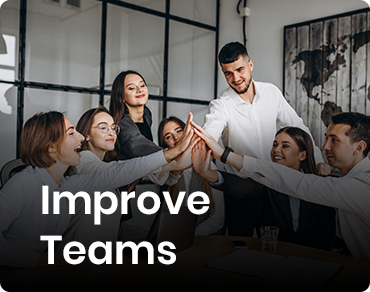Building blocks of the next generation of Organisations
No matter what the future brings, building a capable and resilient organisation is the need of the hour. At tryScrum, our mission is to help organisations become capable and resilient. In this paper, we will share our experience of some of the tenets that helped organisations we worked with. This model aims to show you what to strive for and how to get started to become a high- performing organisation.
In this constantly changing and challenging world, we need organisations that give everyone the power to make decisions and innovate to stay relevant and competitive. We know that you have already reimagined your business for efficiency, speed, and responsiveness. Now it’s time to resurrect your business for adaptability, innovation, and engagement so that you can stay capable. We can help. Let’s try Scrum.
At tryScrum, our mission is to help organisations become more capable and resilient by humanising workplaces. Some of the critical building blocks of next-generation organisations are illustrated below.
Feature Factory → Zero Distance to Customers
The traditional feature factory way of thinking must give way to customer-centric thinking. Team communication is lacking in feature factories. Without any kind of feedback, features are passed from one team to the next. Teams thus find themselves cut off from clients. It takes dedication and practice to transition away from feature factories and toward solving business problems. Not all groups have the authority to consider customers. Getting teams to think beyond features is the first step. Customers will become a direct extension of your business by working more closely with your teams; if engaged, they will stick around.
Co-workers → Community
Coworkers are no longer colleagues. Having devoted communities aid in the organisation's ability to conduct its business, sustain itself, and produce excellent results. A strong community is essential to a successful organisation. Candidates seeking jobs are more motivated to work for the organisation and advance its mission when they feel they can be themselves at work. Factors including mission, values, expectations, goals, and work environment make up an organisation's culture. And company culture can be compared to a company's "personality.
Top-down co-ordination → Voluntary co-ordination
On the subject of coordination, there is a wealth of information available. Sadly, there is a knowledge gap in assisting organisations in understanding strategies that can influence their agility and support teams in change. tryScrum is aware of this, and we want to help organisations embrace voluntary coordination to release collective intellect. Coordination that is voluntary improves commitment and self-control.
Hierarchy → Accountability
The majority of businesses are designed with a rigid hierarchy in place. There is a presumption that decision-making is normally done by those in higher positions, which benefits superiors and allows businesses to flourish at what they know and do best. However, leaders must accept that they can only do so in a more dynamic environment, where good ideas take precedence over traditional reporting structures and where everyone, regardless of rank, has the opportunity to help the company move in the direction it needs to go. This is especially true for organisations that need to change quickly and pursue new strategies.
Unit Performance → Shared Outcomes.
Farm silos are made to separate various ingredients while storing vast quantities of grain. Organisational silos in firms have the same result: They restrict communication between teams and departments by keeping people and information separate. It can make a significant amount of waste enter the system. Organisational silos must be eliminated as soon as possible for enterprises to expand. Silos are more challenging to break down in larger organisations, so it's critical to do so as quickly as possible—or even before they form. All-hands meetings are not necessary to maintain your organisation's focus on common objectives and results; instead, you need collaborative settings that emphasise customer-centricity.
Establishment → Experimentation
The traditional approach to strategic Management is essentially sequential. The organisation first decides where and how to do business, then plans to execute that decision, and then tries to execute the plan. This approach is like placing a bet on the future: one builds an expectation of what the distant future will bring and then rushes forward to be the winner in that future. This approach is unsuitable for the VUCA world in which it is difficult to predict the distant future accurately. For an organisation to be viable, it must be capable of producing a range of responses that are as diverse as the challenges posed by the environment. In times of uncertainty, embracing an experimental approach is inevitable. Only an experimental mindset can embrace experimentation. Equip everyone with the skills they need to design and run their own experiments
Centralised Innovation → Distributed Innovation
Innovation is an ongoing process rather than an event. Due to inadequate product segmentation, around 95% of new products fail (Clayton Christensen). The decision-making process is frequently centralised in Traditional Organizations. In the VUCA era, decentralisation is a concept that increasingly organisations are embracing. Decentralisation moves an organisation's planning and decision-making duties from a single, central location. An alternate framework for managing innovation is provided by the successful development of the Linux operating system and countless other open-source software (OSS) projects ( The principles of Distributed Innovation, 2007). The appearance of distributed innovation systems is most fully illustrated by open source software (OSS) communities, which feature decentralised problem solving, self-selected participation, self-organising coordination and collaboration, "free" revealing of knowledge, and hybrid organisational models that combine community success with commercial success. The public has become aware of the distributed innovation paradigm because of the successes of OSS groups. By putting this concept of distributed innovation into practice, you may include all potential groups in the process and involve them at every stage of your strategy. This includes all employees, stakeholders, clients, and others who interact with your organisation.
Close Department → Open adaptive system
Most businesses are structured along functional lines, with departments for related tasks. Teams become segregated when departments are staffed by workers specialising in particular work areas. Employees from other groups must have the chance to interact and exchange ideas in order to ensure the long-term development of the company is maintained. The manager of a corporation must accept complexity as a given and comprehend complicated adaptive systems. Almost all businesses, big and small, have complexity built into them. An organisation can be seen through the same lens as a result. A successful company must continuously adapt to the changing global environment. An organisation's flexibility gives it a substantial competitive advantage. If your competitive environment is unstable and undergoing rapid change, you need a flexible strategy to stay ahead. Adaptation is tenacity on a larger scale than simply hitting your head against a wall and hoping for a different outcome.
Practices-Driven → Principles Driven
“As to methods, there may be a million and then some, but principles are few. The man who grasps principles can successfully select his methods. The man who tries methods, ignoring principles, is sure to have trouble.” ― Harrington Emerson. Applying procedures and practices without regard for principles is equivalent to throwing darts aimlessly at a dartboard in the hopes of connecting. The way we use these tools, tactics, and procedures matters; methods should be flexible. Principles guide us in the right direction and help us accomplish our objectives while enabling the replication of our achievements and a deeper comprehension of our mistakes. Making our principles clearer can help us understand the "why" behind the "what" we do as leaders.
Concluding Thoughts
These recommendations are based on our experience and have been able to help organisations reimagine their way of working. We hope these tenets will be helpful to the next generation of organisations to build a workplace that is capable and sustainable.
References
- https://www.researchgate.net/publication/24090028_The_Principles_of_Distributed_Innovation Sykes T. (2019, December 2).
- Why you need to learn to adapt. Retrieved December 9, 2019, from https://www.entrepreneur.com/article/343047
How tryScrum may help ?






